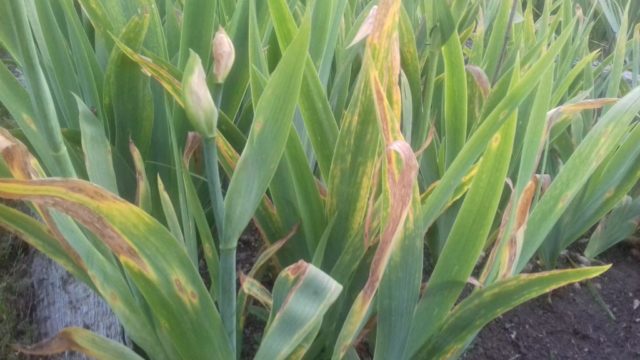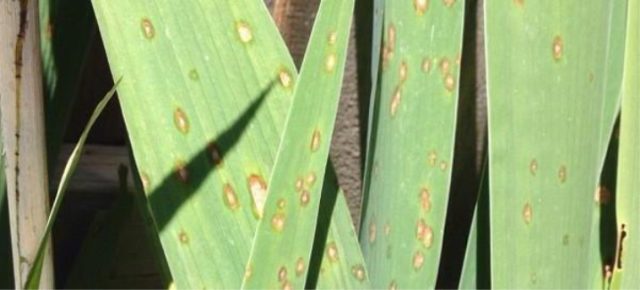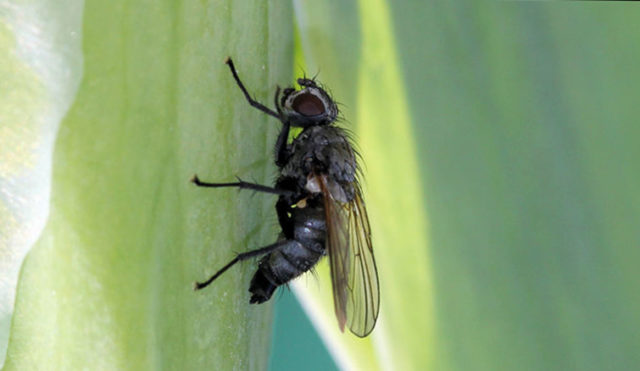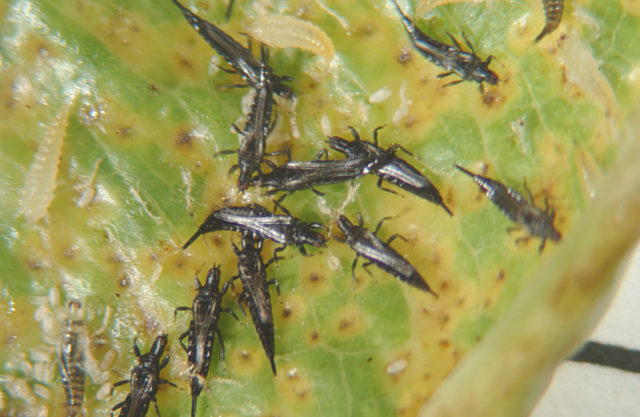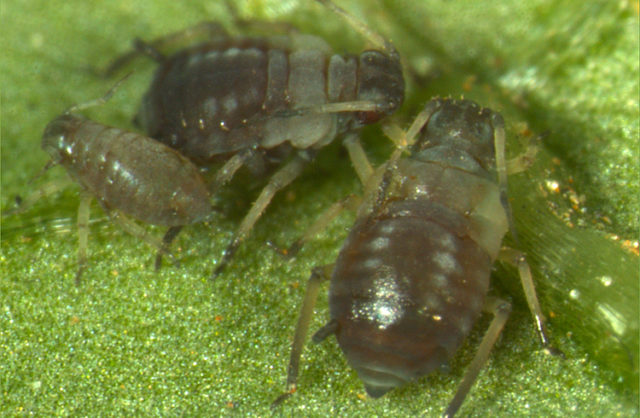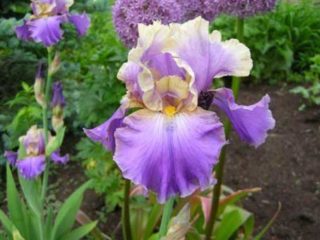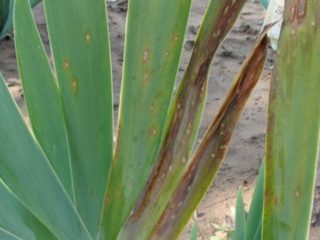Content
Irises are perennial herbaceous plants found on all continents. Many of their species are grown as decorative, they are used to decorate personal plots, park areas, gardens. A variety of these flowers are bearded irises, this is one of the most numerous groups of perennials, numbering many varieties of various sizes and colors.
General description of bearded irises
Bearded irises are rhizome perennial flowers that are widespread in many climatic zones of different parts of the world. Here is a short description of the main parts of this plant:
Parameter | Value |
Plant type | Perennial herb |
Shoots-peduncles | Smooth, round, single, can grow in bunches, the height depends on the variety |
Leaves | Xiphoid, long, green with a grayish tinge, flat, with a pronounced longitudinal texture, growing from the base of the stem |
Root system | Rhizome with a small lobe, growing strongly with age |
Flowers | Large, consist of 6 accrete wavy petals growing from a tubular corolla, while 3 of them are raised, the other 3 are lowered. The color and texture of the color depends on the variety |
Flowering time | April-June, some varieties bloom later |
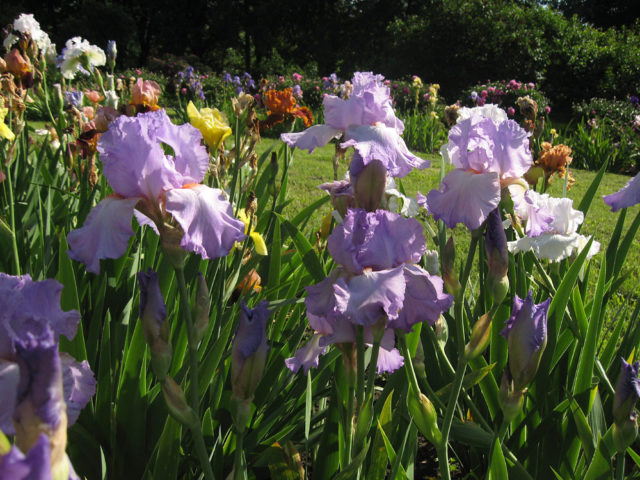
Bearded irises are the largest group of these plants.
Why is the bearded iris called that?
Bearded irises get their names from the numerous hairs located at the base of the petals. They form the characteristic "beard".

The characteristic "beard" of hairs on the petals gave the name to this type of irises.
Classification of varieties of bearded irises
Bearded irises are classified according to several characteristics. These are the height of the peduncle, the beginning and duration of flowering, the size of the flower and the nature of the color. In the international classification, these parameters are indicated by the corresponding Latin names and symbols that indicate on the packaging with planting material.
Classification of bearded irises by peduncle height (table):
Name | Height, cm | Designation |
Miniature dwarf | Up to 20 | MDB |
Standard dwarf | 20-40 | SDB |
Intermediate bearded | 41-70 | IB |
Curb | 41-70 | BB |
Miniature tall | 41-70 | MTB |
High | 71-120 | TB |
Classification of bearded irises by the beginning of flowering (table):
Name | Designation |
Very early | VE |
Early | E |
Average | M |
Mid late | ML |
Late | L |
Very late | VL |
Repaired (long flowering) | Eml |
Classification of bearded irises by the nature of the color with names in Latin (table):
Designation | Latin name | Description |
Plain | Self | The petals are uniformly colored |
Two-tone | Bitone | The perianth is painted in different tones of the same color |
Bicolor | Bicolor | The color of the petals is a different combination of 2 colors |
Amena | Varieties with white upper petals and variegated lower petals | |
Variegata | The upper petals are yellow, the lower ones are dark red | |
Blend | Iridescent, colors gradually merge into each other | |
Plicata | Dark dots, streaks, or borders on white, pink, or yellow perianth | |
Glaciata | Coloring without anthocyanin shades | |
Luminata | Dark perianth is painted with light veins | |
Neglecta | Upper lobes are light purple, fouls are purple | |
Funcy-plicata | Color combination Plicata and Luminata | |
Two-tone + two-tone | Reverse | Darker than foul standards |
Broken color | Randomly colored |
In addition, bearded irises are classified by flower size, highlighting varieties with small, medium, large and largest.
When and how the bearded iris blooms
The flowers of the bearded iris look very unusual. Perianths consist of 6 lobes-petals, 3 of which are raised up, and 3 are lowered downward. In the specialized literature, they all have their own names. The 3 lower petals (outer lobes) are called fouls, the 3 upper petals (inner lobes) are standards. A pistil with 3 wide lobes and numerous stamens are hidden behind them. The petals of the bearded iris have a wavy edge, often referred to as lace.

Irises bloom very beautifully, regardless of color
Iris bloom starts quite early. In regions with a warm climate, dwarf varieties can bloom as early as April, then buds appear in medium-sized plants. The largest varieties bloom at the end of May. If you choose the right species, then the continuous flowering of irises can be admired for about 1.5 months.
Winter hardiness of bearded irises
Not all varieties of bearded irises are distinguished by good frost resistance. Cooling down to -12-14 ° C is critical for most of them, and for some, even half the temperature may well turn out to be fatal. For this reason, in most regions of Russia, irises need some kind of shelter for the winter.
The best varieties of bearded irises
Of the thousands of varieties and hybrids of bearded irises, you can always choose the best one, focusing on the necessary parameters, such as size, color or flowering time.
Succes fou
Bearded iris Suxes Fu belongs to large varieties of medium late flowering period. Peduncles are powerful, stable, grow up to 0.9 m. Standards are pink flamingos, fouls are pink coral. The flowers are very large and beautiful, with a reddish-pink beard.
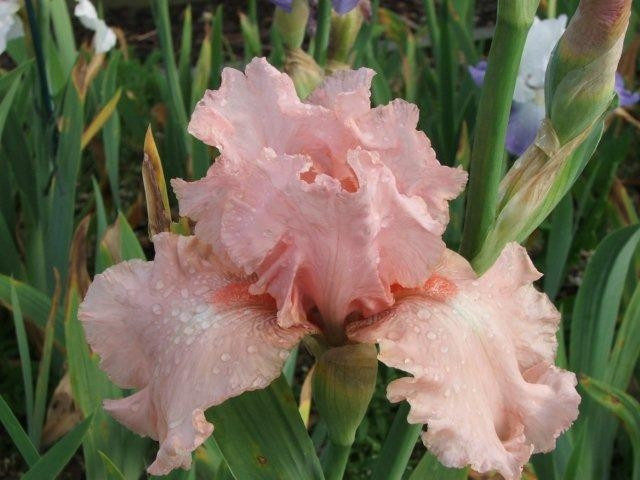
Sucks Fu, despite its great height, can be grown without tying
Medici prince
The Medici Prince is one of the largest varieties of bearded irises with a two-tone color. Peduncles are strong, stable, can reach a height of 1 m. The outer perianth lobes have a rich wine color, the inner ones have a lighter ruby-red hue.

Prince of Medici - a variety with a pleasant wine color
Decadence
This medium-flowering bearded iris is a tall variety. Peduncles grow to a height of 0.9-0.95 m. The petals have a strongly corrugated edge. The standards are light apricot in color with a cream shade, the central veins are pinkish. The fouls are burgundy with a small cream border. The Decadence beard is orange with a tangerine tint.
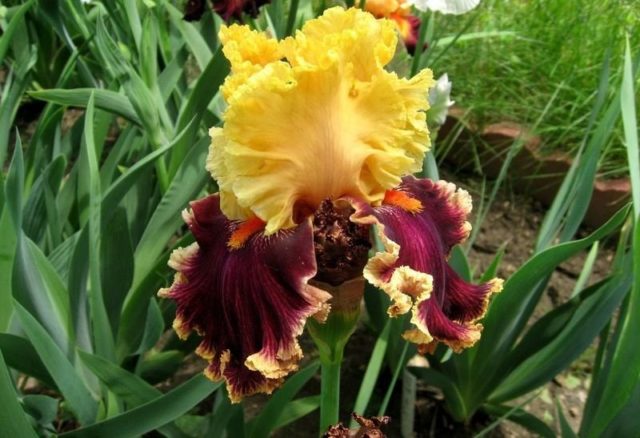
Edges of Decadence fouls are painted in the same tone as the standards
Devil's Lake
It is not for nothing that this variety of bearded irises is called "Devil's Lake" in translation, there is something mystical in it. Its petals have a solid dark ultramarine color, both fouls and standards, and look quite ominous. The flowers are very large, the size of a human palm, powerful peduncles can grow up to 1 m.Devils Lake belongs to the tall varieties of late flowering.
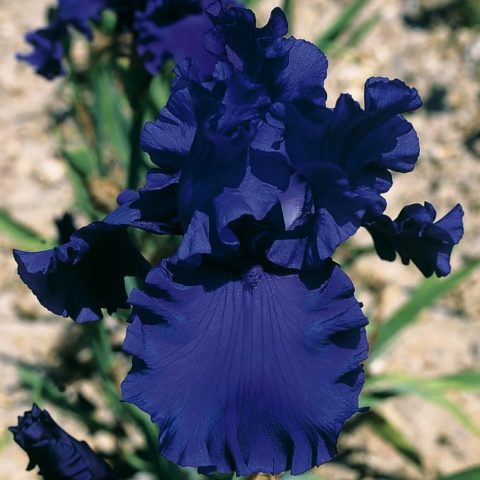
Very unusually colored bearded iris - Devils Lake
Magical glow
A very bright and eye-catching variety of tall, bearded irises with a tangerine-orange solid color of fouls, the standards have a bronze tint and are slightly more corrugated. The beard is tangerine red. The flowering period is average. Peduncles can grow a little more than 1 m.
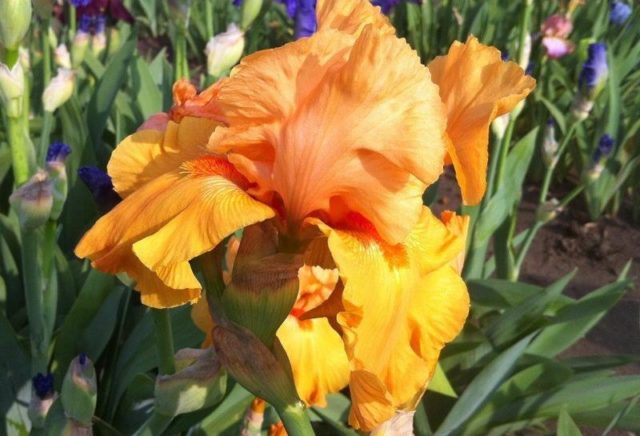
Magic Glu refers to tall varieties
Sultan Palace
The variety belongs to the border, flower stalks grow up to 0.6-0.9 m. Sultans Palace blooms late, at the end of May. The standards of this bearded iris are red, the fouls are darker, with black markings around the edge of the petals. The beard is yellow.
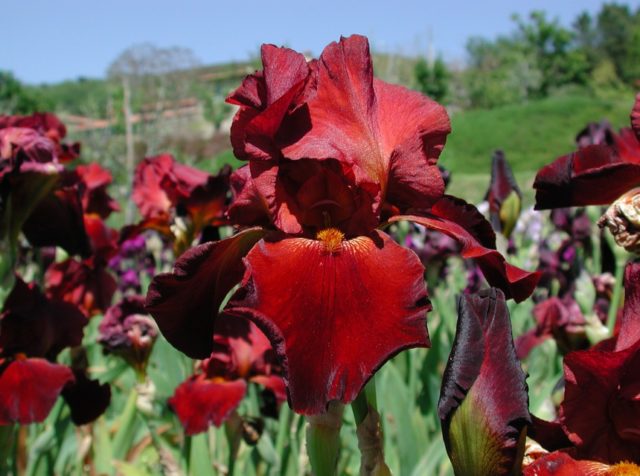
Important! Irises Sultan Palace stand perfectly in the cut.
Irises Sultan Palace are well suited for cutting
Supreme Sultan
Supreme Sultan is an excellent decorative variety of bearded irises with a two-tone color. The standards are yellow-orange, with a pumpkin hue, the fouls have a rich velvet mahogany color. The beard is tangerine-burgundy. Supreme Sultan peduncles are tall, growing up to 0.9-1 m. Flowering is very late.
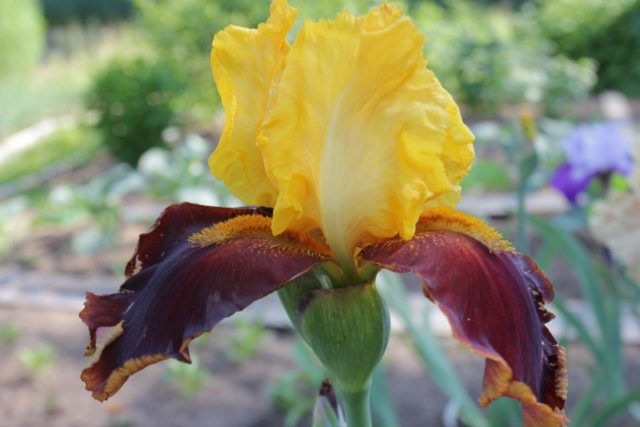
Very late flowering variety - Supreme Sultan
Pink Taffeta
Bearded iris Pink Taffeta is classified as curb iris, its height is usually 0.7-0.8 m. Fouls and standards are pink, wavy, with a light carrot beard. Blooms late in June. The flowering period of Pink Taffeta is about 3 weeks.
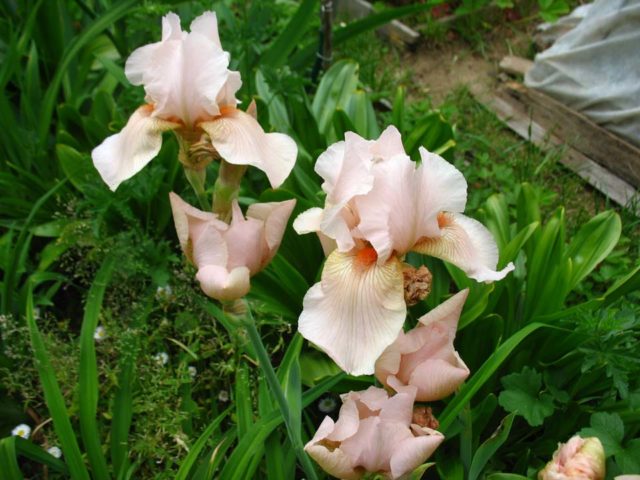
The curb variety Pink Taffeta has lace petals
Copatonic
This variety of lacy bearded irises is considered one of the most beautiful. The standards are light brown, with a creamy shade, the fouls have a ruby brown velvety color, the border is light. Copatonic's petals are highly corrugated, with a mustard-colored beard. Refers to medium early varieties, peduncles grow to 0.8-0.85 m.
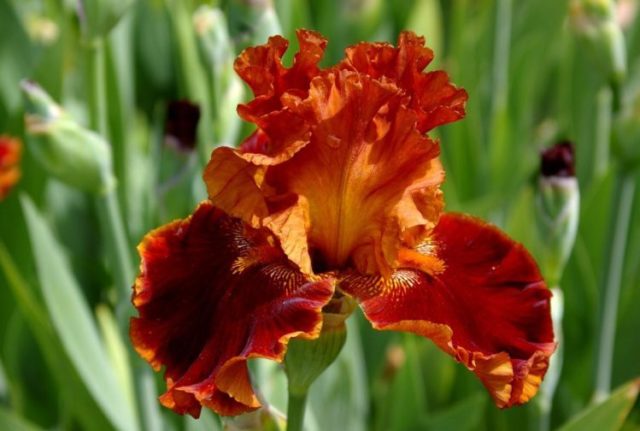
One of the most decorative varieties of bearded irises - Kopatonic
Torero
Bearded iris of medium-late blooming Torero can grow up to 0.8-0.9 m.Coloring is very bright, catchy, standards are orange, apricot shade, fouls are brick-red, velvety, lighter rays are clearly visible near the carrot-colored beard.
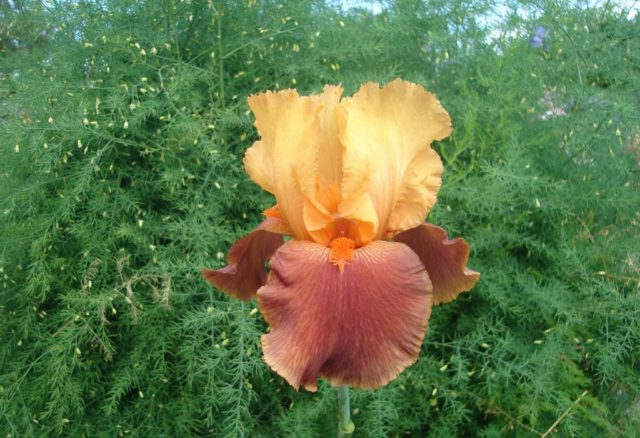
Iris Torero has a very bright color
Wabash
Belongs to high, peduncles can grow up to 0.9 m. The flowering period is average, the first buds appear in early June. Wabash standards are snow-white, the lower lobes are violet-blue, inky shade, with a thin white blurred border. The beard is golden.
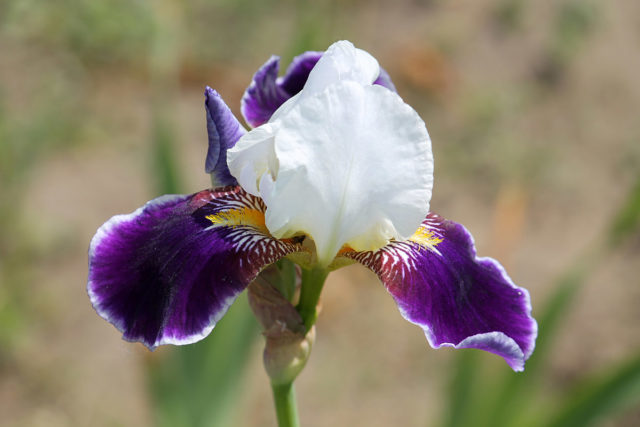
Wabash is an old and well-deserved variety of bearded irises
Ever after
This is a mid-late variety of bearded irises, growing to a height of 0.9-0.95 m. Fouls and standards are corrugated, painted in lilac, lighter in the center of the petal. Tangerine beard.
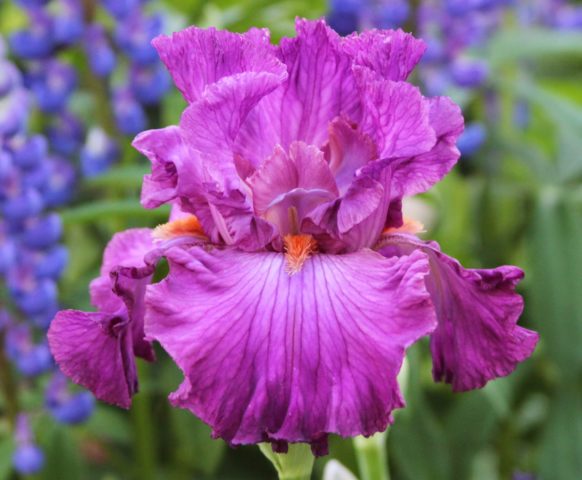
Ever After's heavily crimped petals give the flower a splendor
Bearded irises in landscape design + photo
Among landscape designers, special beds designed only for irises - iridariums, are especially popular. Varieties with different flowering periods are planted on them in such a way that the process is continuous. The photo below shows bearded irises as elements of landscape design.
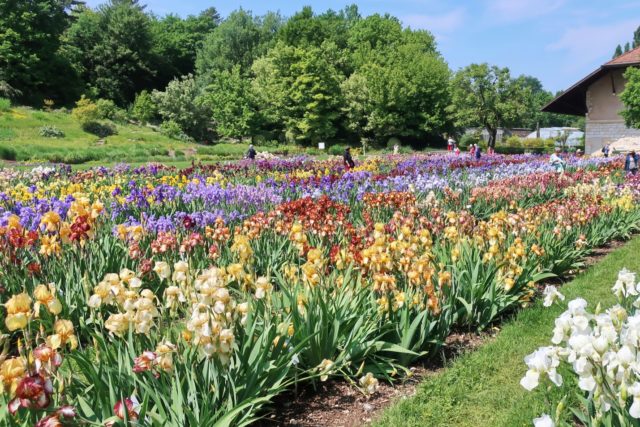
Iridarium - a large flower bed filled with irises of different flowering periods
Bearded irises are often used as curbs, framing alleys, garden paths with them, they are often planted along fences, walls, architectural objects.
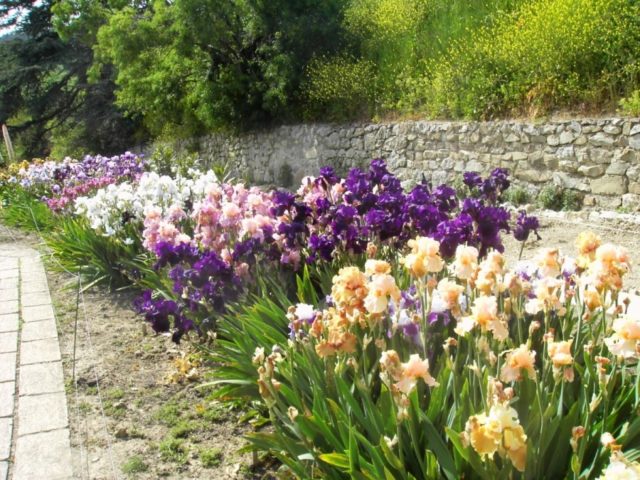
Irises look great as curb plants
Bearded irises, planted near water bodies, look good. In this case, the garden bed with them is raised, since these plants do not like excess moisture. Low varieties are planted on alpine hills, in Japanese gardens.
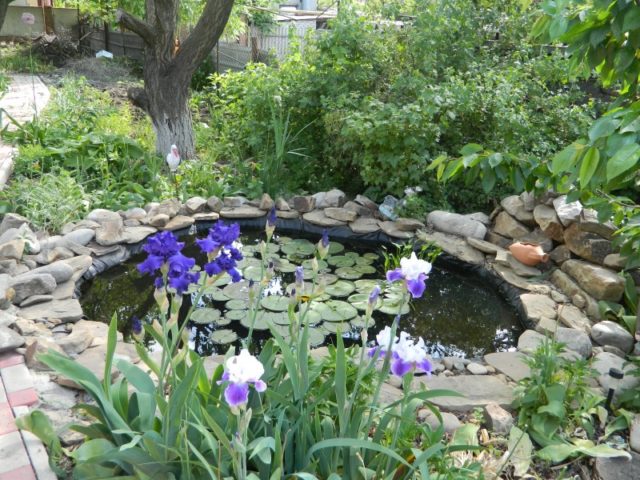
Irises look especially beautiful by the water
Is it possible to plant bearded irises on the balcony
Bearded irises can be grown on the balcony, but for this it is better to use dwarf and miniature varieties that grow no higher than 0.4 m.The soil for planting should be breathable and light. A soil-peat mixture is suitable, to which you need to add a little superphosphate and ash.It is not recommended to use organic fertilizers when growing irises at home.
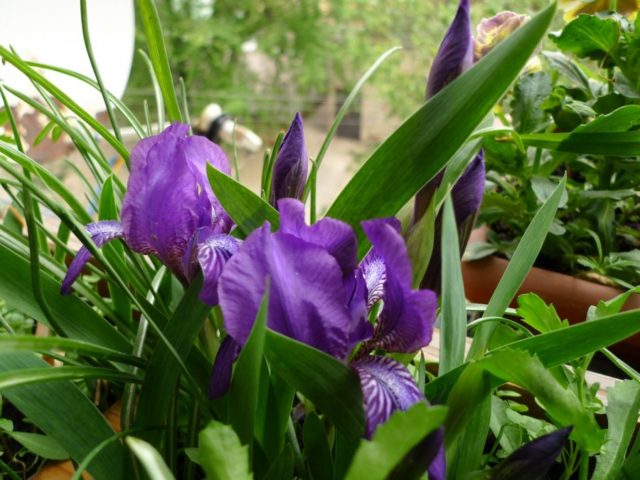
It is better to grow low irises on the balcony.
The rhizome is planted in a small depression in the ground, while the plant itself should have a slight slope to the north. Watering should be done in moderation, excess moisture is harmful.
Features of the reproduction of bearded irises
The most common breeding method for varietal bearded irises is by dividing the rhizome. Over time, the root of this plant grows strongly, neighboring plantings begin to interfere with each other, the quality of flowers decreases. To avoid such a situation, once every 4 years, irises are dug out of the ground and divided into parts, each of which subsequently becomes first planting material, and then an independent flower.
How to plant bearded irises correctly
Before planting bearded irises, you need to choose the right variety suitable for growing in the local climate, and prepare the site. The place for flowers should be well lit, isolated from the north wind. Irises grow well on the southern side of the walls, fences, on the slopes of the hills facing the sun. The soil should be loose, breathable, with a level of acidity close to neutral.
The site must be dug up a few weeks before planting, clearing it of weeds and debris. It is best to plant flowers in late summer or early fall, after the plants have faded. If the planting material was purchased in the spring, then the rhizomes of bearded irises can be planted in open ground after the ground warms up to + 10 ° C.

Iris rhizome is planted on a special mound
Planting bearded irises is easy. Rhizomes are planted in shallow holes, in the center of which a mound of earth is poured, roots are spread along its sides. After that, the pits are filled up, making sure that the upper part of the rhizome with growth buds remains above the soil surface. If the rhizome is completely buried in the ground, the iris will not bloom and may even die. The interval between neighboring plants depends on the height of the variety, for dwarf plants it is 0.2-0.3 m, for large plants - 0.5-0.8 m. Planting is completed with abundant watering.
Care for bearded irises
Caring for bearded irises is easy. For abundant flowering, they need to be fed from time to time with potassium-phosphorus fertilizers, usually this is done during autumn planting, early spring and in the budding phase. As a rule, organics are not used for irises. Watering for these plants needs moderate, in most regions they have enough atmospheric precipitation. Excess water is harmful. Be sure to loosen and mulch the soil, this will not only retain moisture, but will also saturate the roots with air.
Preparing for winter
Before the onset of winter, the foliage of irises is pruned at a height of 10-15 cm from the ground in a fan or cone, and the old withered leaves are removed completely. In this state, the bushes remain for the winter. For better resistance to frost at the end of autumn, they can be fed with wood ash.
How to cover new landings
Young irises transplanted only in autumn should be covered with spunbond or a small layer of mulch made from dry peat, fallen leaves or needles. The film cannot be used for this purpose. After the arrival of winter, the plantings are additionally covered with snow.
Diseases and pests
There are many diseases in bearded irises, and most of them are a direct result of improper planting or care.
- Alternaria. Fungal disease detected by black spots on the leaves. The diseased plant must be destroyed, and the neighboring plantings must be treated with fungicides.
Black spots on the leaves are a sign of Alternaria
- Ascochitis. The appearance of this fungal disease is indicated by the brown edges of the leaves, which gradually begin to dry out. The affected parts of the plant must be torn off and burned.Prevention of the appearance of ascochitis is the treatment of flowers with preparations containing copper.
Drying of the edges of the leaves can be the result of ascochitis.
- Rust. In case of a disease, the leaves become covered with a brown bloom in the form of rounded pads, around which the dying off of healthy tissue begins. The affected leaves are cut off and burned, the plants are treated with preparations containing sulfur.
Rust appears on the leaves in the form of rounded brown pads
No less dangerous for bearded irises are pests, of which this plant has a lot:
- Iris fly. The insect gnaws at the petals, greatly reducing the decorative effect of flowers. To combat the iris fly, Actellik, Decis preparations are used, some gardeners also use folk remedies, such as tobacco dust, soap solution, water infusions of wormwood, celandine and other bitter herbs.
The evil enemy of irises is the iris fly
- Thrips. Insects feed on cell sap, because of this, the plant withers, dries and may die. They fight thrips by treating plants with karbofos.
Thrips can cause serious damage to plants
- Aphid. On irises, you can often find its bean variety. Numerous insects feed on the sap of the plant, which causes it to dry out and wither. They fight aphids with the help of Iskra, Konfidor, Komandor and others.
Bean aphids reproduce rapidly
Prevention of the appearance of diseases and pests is good agricultural technology, keeping the beds clean, adhering to the rules of care.
Conclusion
Bearded irises enjoy the well-deserved love of gardeners. These are universal flowers that can decorate any garden or park, the abundance of varieties with a wide variety of characteristics makes them a great tool in the hands of a landscape designer. Bearded irises are unpretentious and undemanding to care for, and good frost resistance makes it possible to grow them even in cold regions.

